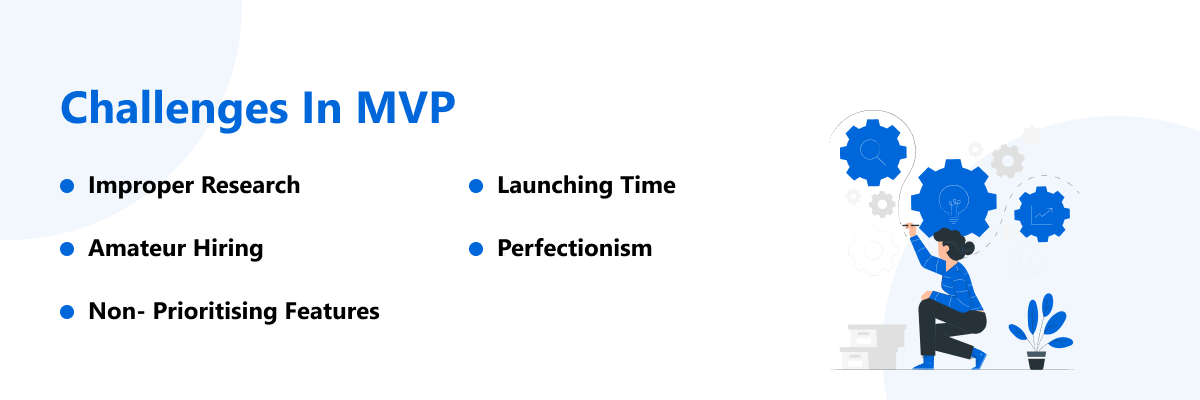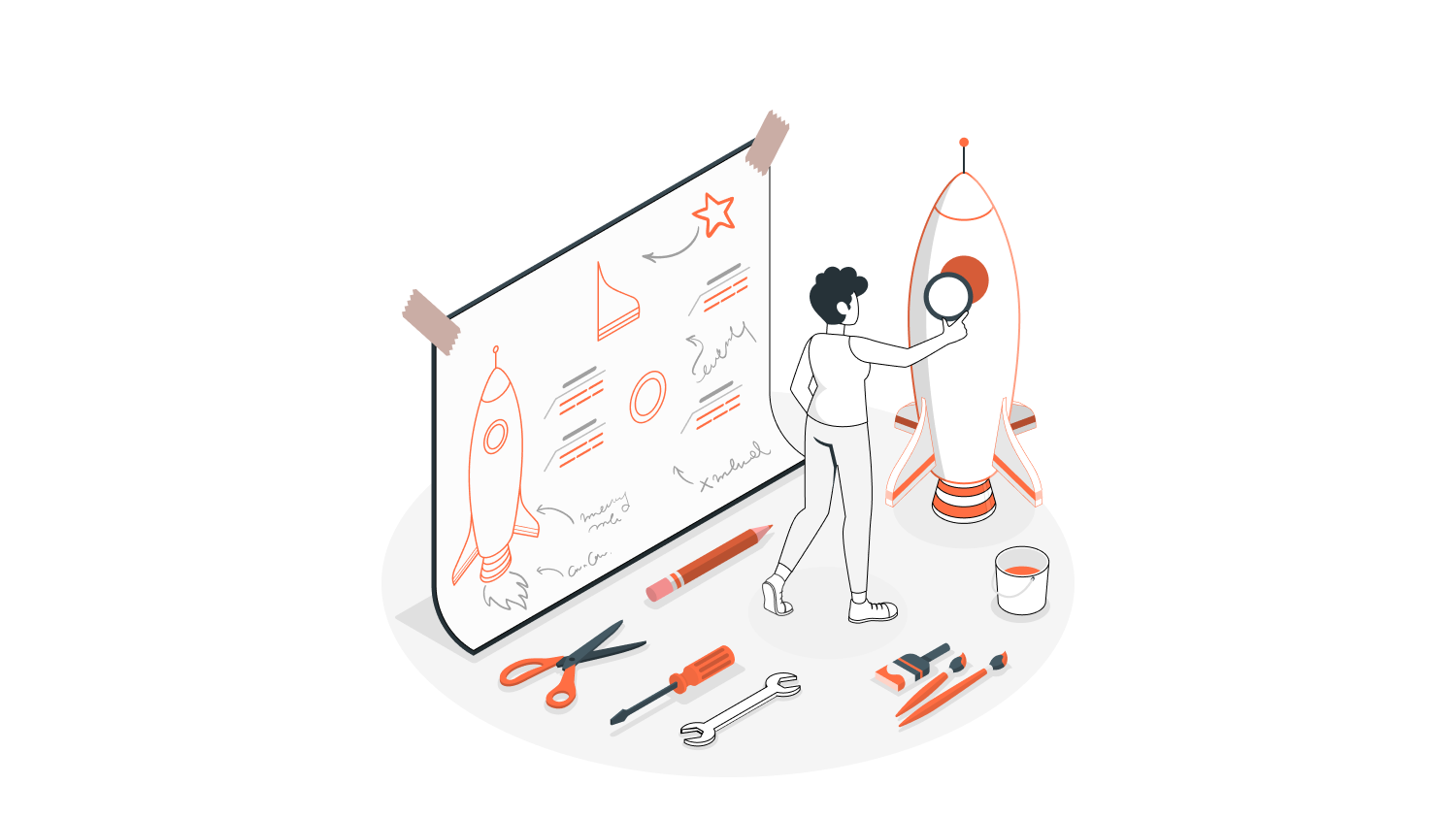You have a great product idea that provides an excellent solution for your target customer’s pain point and dream of launching it someday. Awesome!
But ever thought of validating your idea before betting big on the product? If yes, then MVP software development is what you need to proceed with.
Developing a Minimum Viable Product (MVP) will help validate your product idea faster.
MVP gives a lot of room for improvement and updates and provides validation about your idea at the early stage itself. By knowing this, you can confidently invest a large amount of money and develop your market fit product.
What is MVP Software Development?

Minimum viable product software development is a basic and launchable version of your new tech product. MVP consists of essential features that offer a solution to the target customers.
But it won’t be a market fit product with all fancy features and more. With the help of an MVP, you can get user feedback and improve the product according to the market requirements.
MVP won’t demand a large sum of money compared to the development of the final launch product. Also, you can easily attract early investors by showing a basic operational product. Here are some other vital factors that investors look for before investing in your product.
Advantages of MVP
The advantages of MVP software development are good in numbers. Let’s have a look at the crucial benefits here.
-
-
- Clarity of vision at the early to the final stage of development.
- Extreme focus on one core functionality.
- Enables early user testing.
- A better understanding of customer needs.
- Easy updating the product.
- Building a final product based on the feedback from the customer itself – minimal risks.
- Real market validation of your product.
- You can easily implant flawless user interference.
- Faster release of your market fit product.
- Budget-friendly development.
-
Nowadays, every startup is looking for MVP software development in order to save time, cost, and reduce risks.
How to Prioritise Features for Your MVP?
MVP doesn’t include many features because it will only serve the essential core features. It is crucial to know the features you need to include in the MVP development.
Let’s see how to prioritise features for MVP software development:
-
-
- Study your potential customers and the market.
- List out all the features you are thinking of including in your final product.
- Separate the features into two different categories – WANTS and NEEDS.
- The features in the need category are what we need in the MVP software development.
- The features in the want category are what we will include one by one till we reach the final product.
-
Also, while selecting the features, make sure it is only for the very small community of your target audience. Because you won’t get a large customer base to serve at the early stage.
So select the minimum features which provide the solution to the target customers.
Also, look into the user experience. Even though it only provides the fundamental solution to the small community, you can’t compromise on user experience. For example: if your product is a mobile app, you need to look at the common mobile usability issues and their solutions to improve the user experience.
Read more about prioritising features for your minimum viable product.
How to Build an MVP?
Building an MVP is not an easy task; when compared to the actual product, it won’t demand a lot of work; that’s it.
Also, for MVP development, you should hire experienced app developers for the best results.
Let’s have a quick look at the steps for building an MVP.
-
-
- Market Research
- Define your Idea & Identify the critical point
- MVP Approach Selection
- Find the Ideal Users
- Create the Pain-and-Gain Map
- Prioritise the App Features
- Develop your MVP
- Test, Learn and Repeat
- Measure Success
-
Read the step by step guide to building an MVP to get a more precise idea about it.
Why do MVPs Fail? – Common Challenges in MVP
Even though MVP is a work in progress, it can determine the final product’s success. And there are challenges faced by some startups during the development and use of MVP.
Let’s have a detailed look at the challenges that will lead to MVP failure.

1. Improper market research and audience needs
You have a great business idea that provides an excellent solution. That doesn’t mean your audience really needs the solution.
To make sure your audience needs an answer, you need to do proper market research before, during and even after your MVP launch.
Research will help you find out your target audience, their pain points and how you could solve them.
Doing research will provide you with a lot more information than you assume. Market research is all you need to do before starting your development process. Know the different types of research methods that can help you launch a successful product.
A better understanding of your audience and competitors will provide what to do and what not to do in hand.
Before starting your research, clearly define the goal and idea of your startup. Identify and categorise the target audience according to different demographic categories like:
-
-
- Age
- Gender
- Location
- Occupation/ Designation
- Annual/ Monthly earnings
- Educational qualification
- Relationship status
-
After researching your target audience, you need to focus on your competitor. If there is a competitor, analyse their early stage and current product.
By analysing their early stages, you can clearly know what to do and what not to. By analysing their product, you will understand the features they are not providing. This will help you understand what you should include in your product.
Bear in mind that: Failing to have in-depth research and not correctly understanding the requirements from the audience is one main reason for MVP failure.
Without proper research, you may develop a different product, which is not the right solution for your audience.
Also Read: 6 Biggest Mistakes Entrepreneurs Make that Lead to Business Failure
2. Limited skills by hiring amateurs
Although MVP is an early product with basic functionality or limited skills, the user experience would be limited.
Many startups won’t hire experienced or highly skilled people for MVP software development. Instead, they think of having a professional team to develop the final product and cut costs in developing their MVP.
This will lead to much chaos while creating the Minimum Viable Product. You may cut costs by hiring less-skilled developers or designers but remember it also cuts the quality of the product.
You need to hire a well-experienced team or outsource the development to the product development companies that have experience in MVP software development for your niche market.
If you hire fresh developers, make sure to have a well-experienced manager or lead to guide them.
3. More or less features
The necessary features are the ones that need to be included in the MVP development. If you crowd your MVP with a lot of advanced features, it will consume a lot of money, time and resources.
If MVP itself costs you a lot, then there won’t be any room for improvement till we reach the final product.
Always remember MVP software development is an iterative process, not an end product. So at the start, try to keep things simple and produce a product that performs basic functions.
It’s always best to prioritise the features to be included beforehand to avoid chaos.
Try to understand what features are actually needed and which ones are wanted? Prioritise them. Never avoid the features that affect the user experience and the flow of the app.
You should include the feature for customer feedback because the primary purpose of the MVP is to improve based on your customer requirements.
4. Risk of early or delayed launching
Timing is everything. Even on releasing the MVP, you have to be more precise about the launching time of your product.
Many startups have launched their product at the wrong time, which leads to product failure as they do not reach potential customers.
Try to understand the market moods and set an appropriate time for the launch.
Never try to launch too early before developing the necessary features. It will be hard if you hit the early customers with a product that doesn’t provide the solution.
Delaying the launch also creates other competitors to evolve in the industry before you.
Estimate and create a deadline for the product launch beforehand. Create a pre-launch website to attract more email sign-ups from your potential customers, create a marketing campaign to attract more potential audience.
Read the blog on how to determine the right time for product launch. Also, read the app marketing strategies to stay ahead of the competition and reach the right audience.
5. Trying to be absolutely perfect
Looking to be perfect is good. But being perfect is one of the most important things than any other feature then it is going to be a hurdle.
Many startups which strived to be perfect on their MVP software development failed to launch the market fit product.
Every time you get feedback from your customers, you alter and update the product. Every time you go for perfectionism, the cost, time, and resources will be largely consumed. This ruins the entire concept of the MVP.
MVP doesn’t have to be perfect, it helps you to develop the ideal final product. Evolve with customer feedback and try to create a product that your customer likes rather than perfect.
Minimum Viable Product Examples
Many successful startups are once MVPs. If you are doubting whether creating an MVP is a good idea. Then, have a look at the successful Minimum viable products that turned into a profitable market-fit product.
-
-
- Facebook MVP
- Airbnb MVP
- Amazon MVP
- Buffer MVP
- Twitter MVP
- Uber MVP
- iPhone MVP
- Spotify MVP
- Zappos MVP
- Dropbox MVP
-
We have some tech giants here; yeah, they tried MVP before launching the final product.
How Much Does it Cost to Create an MVP?
The cost of developing an MVP is not fixed. The important factor that affects the cost of developing the MVP is the complexity and number of features you add to the product.
You can hire an experienced team that costs an amount or outsource the development process to a well-established product development company.
Mostly the MVP price will be between $10000 to $15000. And it varies for every project. You can talk to our tech experts to know the details!
Conclusion
With every challenge, you improve, iterate and evolve. Try to be more positive whenever you face challenges. Minimum viable products will be a great advantage if you implement them correctly.
As they say, great people, come from great places; great products come from great MVPs. And fortunately, at NeoITO , we have a great team to help you achieve that. So, don’t hesitate to Contact Us!





